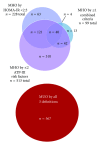All-cause mortality risk of metabolically healthy obese individuals in NHANES III
- PMID: 23304462
- PMCID: PMC3523154
- DOI: 10.1155/2012/460321
All-cause mortality risk of metabolically healthy obese individuals in NHANES III
Abstract
Mortality risk across metabolic health-by-BMI categories in NHANES-III was examined. Metabolic health was defined as: (1) homeostasis model assessment-insulin resistance (HOMA-IR) <2.5; (2) ≤2 Adult Treatment Panel (ATP) III metabolic syndrome criteria; (3) combined definition using ≤1 of the following: HOMA-IR ≥1.95 (or diabetes medications), triglycerides ≥1.7 mmol/L, HDL-C <1.04 mmol/L (males) or <1.30 mmol/L (females), LDL-C ≥2.6 mmol/L, and total cholesterol ≥5.2 mmol/L (or cholesterol-lowering medications). Hazard ratios (HR) for all-cause mortality were estimated with Cox regression models. Nonpregnant women and men were included (n = 4373, mean ± SD, age 37.1 ± 10.9 years, BMI 27.3 ± 5.8 kg/m², 49.4% female). Only 40 of 1160 obese individuals were identified as MHO by all definitions. MHO groups had superior levels of clinical risk factors compared to unhealthy individuals but inferior levels compared to healthy lean groups. There was increased risk of all-cause mortality in metabolically unhealthy obese participants regardless of definition (HOMA-IR HR 2.07 (CI 1.3-3.4), P < 0.01; ATP-III HR 1.98 (CI 1.4-2.9), P < 0.001; combined definition HR 2.19 (CI 1.3-3.8), P < 0.01). MHO participants were not significantly different from healthy lean individuals by any definition. While MHO individuals are not at significantly increased risk of all-cause mortality, their clinical risk profile is worse than that of metabolically healthy lean individuals.
Figures


Similar articles
-
Metabolically healthy obesity and risk of mortality: does the definition of metabolic health matter?Diabetes Care. 2013 Aug;36(8):2294-300. doi: 10.2337/dc12-1654. Epub 2013 May 1. Diabetes Care. 2013. PMID: 23637352 Free PMC article.
-
Metabolically healthy obesity, vitamin D, and all-cause and cardiometabolic mortality risk in NHANES III.Clin Nutr. 2019 Apr;38(2):820-828. doi: 10.1016/j.clnu.2018.02.025. Epub 2018 Mar 2. Clin Nutr. 2019. PMID: 29525513
-
Mediterranean diet and mortality risk in metabolically healthy obese and metabolically unhealthy obese phenotypes.Int J Obes (Lond). 2016 Oct;40(10):1541-1549. doi: 10.1038/ijo.2016.114. Epub 2016 Jun 24. Int J Obes (Lond). 2016. PMID: 27339604
-
Identifying metabolically healthy but obese individuals in sedentary postmenopausal women.Obesity (Silver Spring). 2010 May;18(5):911-7. doi: 10.1038/oby.2009.364. Epub 2009 Oct 22. Obesity (Silver Spring). 2010. PMID: 19851302
-
Do worse baseline risk factors explain the association of healthy obesity with increased mortality risk? Whitehall II Study.Int J Obes (Lond). 2019 Aug;43(8):1578-1589. doi: 10.1038/s41366-018-0192-0. Epub 2018 Aug 14. Int J Obes (Lond). 2019. PMID: 30108269 Free PMC article.
Cited by
-
Estimation of risk for diabetes according to the metabolically healthy status stratified by degree of obesity in Korean men.Endocrine. 2015 Dec;50(3):650-8. doi: 10.1007/s12020-015-0635-5. Epub 2015 May 29. Endocrine. 2015. PMID: 26022652
-
Clinic, Anthropometric And Metabolic Changes In Adults With Class III Obesity Classified As Metabolically Healthy And Metabolically Unhealthy.Diabetes Metab Syndr Obes. 2019 Nov 27;12:2419-2431. doi: 10.2147/DMSO.S210616. eCollection 2019. Diabetes Metab Syndr Obes. 2019. PMID: 31819568 Free PMC article.
-
A novel criterion of metabolically healthy obesity could effectively identify individuals with low cardiovascular risk among Chinese cohort.Front Endocrinol (Lausanne). 2023 May 26;14:1140472. doi: 10.3389/fendo.2023.1140472. eCollection 2023. Front Endocrinol (Lausanne). 2023. PMID: 37334301 Free PMC article.
-
Relationship between Nonalcoholic Fatty Liver Disease and Vitamin D Nutritional Status in Extreme Obesity.Can J Gastroenterol Hepatol. 2017;2017:9456897. doi: 10.1155/2017/9456897. Epub 2017 Jun 8. Can J Gastroenterol Hepatol. 2017. PMID: 28685131 Free PMC article.
-
New obesity classification criteria as a tool for bariatric surgery indication.World J Gastroenterol. 2016 Jan 14;22(2):681-703. doi: 10.3748/wjg.v22.i2.681. World J Gastroenterol. 2016. PMID: 26811617 Free PMC article. Review.
References
-
- Bray GA. Risks of obesity. Endocrinology and Metabolism Clinics of North America. 2003;32(4):787–804. - PubMed
-
- Bray GA. Medical consequences of obesity. Journal of Clinical Endocrinology and Metabolism. 2004;89(6):2583–2589. - PubMed
-
- McLaughlin T, Sherman A, Tsao P, et al. Enhanced proportion of small adipose cells in insulin-resistant vs insulin-sensitive obese individuals implicates impaired adipogenesis. Diabetologia. 2007;50(8):1707–1715. - PubMed
-
- Primeau V, Coderre L, Karelis AD, et al. Characterizing the profile of obese patients who are metabolically healthy. International Journal of Obesity. 2011;35(7):971–981. - PubMed
-
- Blüher M. The distinction of metabolically “healthy” from “unhealthy” obese individuals. Current Opinion in Lipidology. 2010;21(1):38–43. - PubMed
Publication types
MeSH terms
Substances
Grants and funding
LinkOut - more resources
Full Text Sources
Medical

